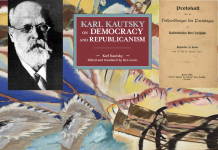In the third article in our series looking at social reproduction, Estelle Cooch considers some of the debates surrounding the development of the theory and asks whether there is enough within Marx’s writings to understand women’s oppression today.

In summer 2012 Fifty Shades of Grey became one of the best-selling books of all time. In August of that year Amazon announced the series had outsold sales of every book in the Harry Potter series combined. The author EL James was interviewed on the BBC’s Newsnight programme. Adverts for it were plastered over every inch of London.
The series depicts the relationship between a college student and her partner, who turns out to be a bondage-loving business magnate. The books are notable not only for the abusive relationship at their heart, but also for their portrayal of an entirely commoditised couple. The lead character is bought an Apple Mac, not a computer; given a Rolex, not a watch.
During that summer, I realised that everyone my age (early 20s) was reading it. Then everyone was reading it. It didn’t matter if they’d gone to university or not, or were in a relationship or not. Something about the books had caught the mood of the time.
Naturally this provoked lengthy, angry debates on feminist blogs. It rekindled many of questions from the “feminist sex wars” of the 1980s – is BDSM oppressive? is porn ever okay? These debates reemerged alongside new feminist movements in India, Egypt and Spain.
Fifty Shades was a culmination of what neoliberalism says about women. They had to be like Anastasia Steele; young, sexy, caring, intelligent, working, but also keen to be a mother. If Fifty Shades was placed in the “fiction” section of bookshops, it should have been filed under “fantasy”.
Yet during this summer something became abundantly clear: Marxists had very little to say about the phenomenon. How could a book about a women’s oppression, about her commodification, about domestic work, become the biggest selling of all time and not provoke a response?
There are two possible reasons – one is that Marxism has no useful analysis of women’s oppression to offer to the new movements that are emerging across the globe. The other reason is that Marxist analyses of women’s oppression have faltered since the feminist debates of the 1980s and struggled to grapple with the impact neoliberalism has wrought upon women’s lives.
This article will argue for the latter position. Marxist analyses of women’s oppression have, in the recent past, been left wanting, but the framework provided by Marx, Engels, Luxemburg – and later Lise Vogel and others – is still useful for understanding women’s oppression today.
The divorce
The rise of the women’s movement in the 1960s and 1970s raised fundamental questions over the role of women in society and their personal relations with men. It also began to recast the meaning of politics for women. Demonstrations and protests went alongside the rise of “consciousness raising”, for example.
Intervening in this terrain was no easy task. Some Marxists offered a kneejerk rejection of all feminist theory. Others were more polite, but similarly non-committal.
But feminists had put their finger on an important issue. Marxists argued that the driver of history was “the production and reproduction of immediate life” [1]. But where was their analysis of reproduction? Absolutely Marx had provided detailed studies of labour power, of factories, of the ins and outs of the cotton trade, but where had he talked of life in the home? What was the value of cleaning? What was the labour power used in giving a child a bath?
Even in Fifty Shades of Grey, Mrs Jones, the housekeeper, plays a pivotal role in ensuring her ungrateful employer returns to work the following day.
These questions concerning “social reproduction” were addressed in the “domestic labour debate” of the 1970s.
One of the ways that Marxism differentiates itself from “bourgeois” theories of society is in its commitment to materialism – in other words theory grounded in the real world. As one writer put it “to be a Marxist is to muck about in the realm of the concrete” [2].
Those involved in the domestic labour debate were trying to take concepts from Capital and apply them to women’s oppression. Needless to say they had varying degrees of success.
The watershed moment was the publication of Margaret Benston’s article ‘The Political Economy Of Women’s Liberation’ in 1969. Benston’s originality lay in her proposal that domestic labour was “productive” in the Marxist sense. She argued that without domestic labour workers cannot reproduce themselves, and without workers capital cannot be reproduced.
Benston laid the groundwork for a series of other authors, most notably Mariarosa Dalla Costa and Selma James, to also argue that domestic labour was productive.
In 1972 Dalla Costa and James published their pamphlet arguing that capitalism, in creating family structures, had freed men from reproducing labour power. As a result women were productive in providing a “safety valve” for social tensions.
The pamphlet had huge political complications. It lay the theoretical foundation for a small but aggressive campaign for wages for housework (although Dalla Costa herself never actually agreed with this demand). It was also cited as the inspiration for Silvia Federici’s seminal Caliban And The Witch. [3]
The problem with their conclusion was that neither of them had understood what Marx meant by “productive”. They confused the usefulness of labour with its social form. It doesn’t matter to Marx what the type of work being done is: what matters is its relation to capital. As Rosa Luxemburg put it:
As long as capitalism and the wage system rule, only that kind of work is considered productive which produces surplus value, which creates capitalist profit. From this point of view, the music-hall dancer whose legs sweep profit into her employer’s pocket is a productive worker, whereas all the toil of the proletarian women and mothers in the four walls of their homes is considered unproductive. This sounds brutal and insane, but corresponds exactly to the brutality and insanity of our present capitalist economy. [4]
This is why Mrs Jones in Fifty Shades of Grey, employed by the main character along with other staff, is during the day a “productive worker”, but when she returns home to do exactly the same work for her family (perhaps without cleaning the bondage equipment), she is unproductive. This will be examined in more detail later on.
In short, both Dalla Costa and James confuse the conditions necessary for exploitation with the process of exploitation itself.
The debate raged on until 1979, when Heidi Hartmann published her long article ‘The Unhappy Marriage Of Marxism And Feminism’, condemning Marxism as “sex-blind”. In it she develops “dual systems theory”, the idea that patriarchy and capitalism are both separate systems to be fought – and both have a material basis.
For Hartmann, and the new radical feminists emerging from the 1970s, the “marriage” between Marxists and feminists was over. If Marxism had been the oppressive husband, feminism had been the long-suffering wife – and now she wanted a divorce.
In the ten years since Margaret Benston’s initial article the political landscape had been transformed. In the domestic labour debates many feminists had concluded that there simply wasn’t a Marxist framework to understand women’s oppression. The election of Margaret Thatcher in 1979 and Ronald Reagan in 1980 corresponded to a period of serious retreat for the left. Disoriented many activists turned their gaze inwards. As one writer puts it the demands in the 1960s for “representation” got submerged into identity politics and demands for “recognition”. [5]
We are going to consider in more detail two questions that kept emerging – and the solutions offered by those who did develop and apply Marxists categories.
First – what is productive labour? Why do Marxists say domestic labour is “unproductive”? Second – how does the reproductive sphere interact with the productive one? Third – what, if anything, did Marx say about all this?
The special commodity
When my lecturer at university asked us to start reading Capital he began by promising us “a riveting read, a page-turner from chapter one!” Capital is no easy read, but what our lecturer meant was that Marx begins Volume One with his profound insight that labour power or “our capacity to labour” is “the special commodity” that keeps the system running.
He writes: “Capital can spring into life, only when the owner of the means of production and subsistence meets in the market with the free labourer selling his labour power. And this one historical condition comprises a world’s history”.
The fact that labour power is a source of value cannot be underestimated. People doing things makes things happen – and yet this simple insight has eluded even the most acclaimed bourgeois theorists.
What follows from this is crucial. If labour power is the hinge on which the whole system turns, how is that labour power itself produced?
One author that seized on Marx’s insight in Capital and developed it further was Lise Vogel, an American sociologist and former civil rights activist. She proposes three ways that labour power is reproduced. [6]
- through daily activities that help to restore the worker allowing them to return to work – this includes food and shelter, but also any psychological care for each other that goes on within the home.
- similar activities directed at non-workers (the elderly, children, the unemployed) who are outside of the production process.
- (perhaps the most obvious) the literal reproduction of new workers – childbirth.
Viewing reproductive labour in this light allows Vogel to get away from assumptions common in the domestic labour debate – “heterosexuality, biological procreation, family forms or generational replacement” [7]. Instead she focuses on the relation of reproductive labour to the system as a whole.
All three ways are linked to the production process. If workers get paid less, they are less able to provide for themselves and those reliant on them. As a consequence they are less likely to have children. Since the beginning of the recession, birth rates have dropped dramatically in Europe. Many financial magazines refer to the “other crisis” – the demographic one. In Spain predicted death rates will exceed birth rates by 2017 [8].
Public services may once have provided care for the elderly or disabled. But neoliberal policies force this care back into the home – increasing the rate of profit by opening up the public sector to private investment and profit.
It’s not just adults performing this unpaid work. Between 2001 and 2011 the number of children (under 18s) providing care in the home to parents or relatives increased in the UK by 19.5% [9].
Work in the home is clearly a vital part of the system. Women may be invisible, but they are also indispensable. Does this mean feminists who argue that it produces surplus value are correct? Is the work in the home “productive”?
Marxists would argue not – but to understand this we have to look at what Marx really meant when he said labour power was a commodity.
Use value and exchange value
For Marx a commodity is something that is produced for exchange in the market. All commodities are made up of two aspects: use value and exchange value. Use value is the quality that makes something useful to people – an apple is useful to eat. Exchange value in contrast arises with the market – it represents how much one commodity is worth in relation to others. The exchange value of an apple is whatever other commodities it can be exchanged for [10].
Use value and exchange value have little direct relationship. Water is useful, yet it’s exchange value is low. Diamonds just look pretty, yet they command an extortionate exchange value.
Marx argued out that the exchange value had nothing to do with “supply and demand” (as most economists today think), but rather was the result of how much labour power had gone into producing the product.
When it comes to the home this distinction is crucial. Labour in the home does not have an exchange value – it is not a commodity bought and sold on the market. It is what Marx calls “concrete labour” – “the specific act of working to produce useful things” [11].
Only labour in the market place can become “abstract labour” which has exchange value. Labour in the home does not produce surplus value – it is not productive in the Marxist sense. Ultimately Dalla Costa and others are wrong. No exchange takes place between women and capitalists that increases the profits of the latter.
This is not to degrade the work that is done in the home. That such vital work is not considered truly viable is an indictment of the warped system we live under, not of that work.
Transition
That’s “productive work” under capitalism. What about the relation between the productive and reproductive spheres? Let’s recap how the capitalist family came about.
The lead up to the industrial revolution didn’t just transform the work that people did: it also transformed the home. In feudal times the peasant household was a unit of production as well as consumption. It consumed things from the system (food, shelter) and produced things for the system – or for the Lord on whose land it worked. Families today do not produce things in their living rooms and sell them on their doorstep. This is an obvious but critical difference.
The peasant family was not “privatised” or closed off from outside society. As Mark Poster puts it “the basic unit of early modern peasant life was not the conjugal family at all, but the village. The village was the peasant’s ‘family’.” [12]
Enclosure of land and urbanisation preceded the Industrial Revolution, and forms of production began to change. This contributed to the increased isolation of the family. Marx and Engels both thought this would eventually lead to the abolition of the family. They were proven mistaken. [13]
There are many reasons for this. The enthusiasm of women to return to the home as a result of appalling working conditions was certainly one of them. To take just one example, the 1853-4 Preston strike was the longest industrial dispute to date in England. There was a prominent campaign within it by women for the “family wage”.
Moreover, the family became a haven in the face of the threat of absolute misery. Angela Davis is particularly interesting on the defence black slaves in the US made of the family. She writes “the family’s vitality proved stronger than the dehumanising rigours of slavery” – family bonds experienced a revival. [14]
Marx recognised that the indiscriminate employment of men, women and children spread the value of labour power over the whole working class family. This ultimately reduced the overall stock of labour power. In the mid 1800s capitalists realised it was in their own interests to reestablish social reproduction within the home. They rapidly put in policies to ensure this.
Consumption
So the family under capitalism is purely a “unit of consumption”. What does this mean? There are two aspects to Marx’s conception of consumption, both are equally important for maintaining capitalism. Marx explains:
The labourer consumes in a two-fold way. While producing he consumes by his labour the means of production, and converts them into products with a higher value than that of the capital advanced. This is his productive consumption. It is at the same time consumption of his labour-power by the capitalist who bought it.
In other words the worker “consumes” things to make them into a higher value – for example, a ship builder “consumes” steel to make ships. This is consumption in the sense of using up, rather than eating. Were the ship builder to eat steel, the reproduction of labour power would cease quite quickly.
Marx goes on:
On the other hand, the labourer turns the money paid to him for his labour-power, into means of subsistence: this is his individual consumption. The labourer’s productive consumption, and his individual consumption, are therefore totally distinct. In the former, he acts as the motive power of capital, and belongs to the capitalist. In the latter, he belongs to himself and performs his necessary vital functions outside the process of production. The result of the one is, that the capitalist lives; of the other, that the labourer lives.
Marx envisions both sides of consumption – at work (productive) and in the home (individual) – as part of a whole process.
So the image of two separate spheres is misleading. Both systems interlock and have to be functional for the whole system to operate. This is so beautifully summed up in Marx’s last sentence: for the capitalist to live, the labourer has to also live.
What happens when the worker goes home? What does this “individual consumption” translate into?
This is the part of Marx’s analysis that several authors – notably Lise Vogel and recently Heather Brown – have tried to develop. The means of subsistence involve workers buying food for themselves, but also their “generational replacement” – children.
Sadly food is not magically prepared and children are not magically catered for. Regardless of much student effort, you cannot eat off dirty dishes. A child cannot wear the same clothes every day after jumping in mud. For the worker to be able to “consume” in the home, domestic labour has to happen.
Why then have women been left doing the vast majority of domestic labour? Is this the root of their oppression?
Vogel’s insight is important here. She deliberately tries to pull away from biological determinist accounts of women’s oppression. Instead she stresses three different forms of social reproduction, as mentioned earlier, only the last one (childbirth) reliant on sexual difference.
But sexual difference has a social context. And it is there that a great contradictions of capitalism comes into play.
working class women during and shortly after pregnancy require at least some reduced employment to look after themselves and their new born. In the short term they cannot participate fully in production, meaning the profits of capitalists suffer. But in the long term capitalism requires a new labour supply.
Vogel identifies the differential roles that men and women acquire in the childbearing months as one of the contributors to women’s oppression. She writes “in principle women’s and men’s differential roles need only last during those childbearing months”, but as a result men come to be seen as a provider of “the means of subsistence”, where women are seen more as the provider of tasks to do with “necessary labour”.
The onset of capitalism created a sharp demarcation between where surplus labour is gained and where domestic labour is performed. In feudal societies this distinction was not so sharp.
Yet Vogel does not identify this as the only contributor to women’s oppression – that would indeed open her up to charges of biological determinism. Her emphasis is entirely on “the context of the actual society in which such differences are embedded”. She goes on “as the socialist tradition has argued, the issue here is property”. [15]
And for social reproduction theory – the issue is capitalism. In no previous society was surplus value extracted from wage labour as it is now. Social reproduction theory aims to be a gendered take on the labour theory of value. If the labour theory of value does not apply to a particular society, then neither does social reproduction theory.
Conclusions
By the end of the 1980s the domestic labour debate had been consigned to academic journals. The so called “feminist sex wars” that debated BDSM and pornography led many to ask if the feminist movement had been a Trojan horse for neoliberalism. The language of “choice” had rapidly been coopted by the system, it seemed. [16]
So what can we take from the debates over social reproduction? And what is their relevance for those fighting today?
The first thing is there remains a huge untapped resource within Marx’s writings concerning the link between production and reproduction. Heather Brown’s incredible study of Marx on gender concludes that his “concept of reproduction is more complex than most accounts allow for. He does not appear to treat production and consumption as completely separate, nor does he appear to treat consumption as a reflex of production. The two are instead dialectically integrated elements of the whole”. [17]
Recent rereadings of Marx are useful; automatic defences of Engels are less so. The republication of Lise Vogel’s seminal work has helped to refocus analysis of oppression on its place within the whole system, and not just within the home. This can at times be a bit abstract, but Vogel’s thoroughgoing studies of Lenin and Clara Zetkin are fascinating. It’s a shame she doesn’t assess the work of Alexandra Kollontai.
The second reason social reproduction is important is because it provides a way of understanding oppression that relies on neither biology, nor the assumption that oppression has always existed. It is a theory rooted in the idea that biological limits are always social [18]. Reproduction involves more than just the creation of human beings – it involves the reproduction of the “capital relation” itself – the worker and the capitalist.
Social reproduction emphasises the type of society where reproduction is taking place. It doesn’t have to take place within the family. Look to the vast Foxconn factories in China today where 230,000 workers receive their food and shelter in huge dormitories, not in families. Likewise consider the millions of slaves throughout history driven to their death and then simply replaced. A system built for profit does not necessarily care about “generational replacement”. But for now at least, it seems that social reproduction is at home, in the home.
The third and final point about social reproduction concerns struggle. Resistance to economic crisis has often been as unpredictable as the system itself. There have been huge strikes against governments have been a feature, but also movements not initially based in the workplace – the indignados, the movements in Turkey and Brazil.
The working class must unite the economic and political spheres by seizing the means of production if it is to lay the foundations for a truly democratic society. But struggle will not necessarily first break out in the productive sphere first. We need to understand reproductive and productive spheres as part of a whole process. Otherwise we are condemned the make the same mistakes (albeit in a different way) as the dual systems theorists.
The recent resurgence of the women’s movement has often focused on issues of rape and sexual assault. This is partly because of an actual increase in reported crimes since the crisis, but also because of the very literal way exhibit the violence of the system. We must not dismiss these movements as single issue campaigns or render ourselves unable to participate in them.
Let’s end by returning to Fifty Shades of Grey. Gender is used as an ideological tool to hide the reality of class. Neoliberalism does not want to push women back into the home, but it does want them to feel guilty and responsible.
Raunch culture, victim blaming and attacking reproductive rights are all ways of doing that, all ways of reordering femininity. But reordering brings with it instability. When women (and men) start to question the system, the whole ideological edifice can come crashing down.
Fifty Shades of Grey with its self-made millionaire and his perfect partner is the story of neoliberalism. Christian Grey declares in book one “Oh, I exercise control in all things, Miss Steele, I employ over 40,000 people.” [19]
We have actually all been conned. Fifty Shades was not just a book about sex, it was a book about the American dream. Anastasia Steele had not only been sucked into an abusive relationship, she had been ushered into the 1 percent. But the solution will have to come from the 99 percent.
We will not end women’s oppression by wearing different clothes, by becoming CEOs, or by having more and better sex. Ending women’s oppression means sending the likes of Anastasia the same way as her Russian namesake – and smashing the world of Fifty Shades of Grey.
This article will be published in En Lucha’s publication La Hiedra later this month, we publish early with their kind permission
[1] Engels, Friedrich, The Origin of the Family, Private Property and the State, 1972, p.71
[2] David McNally and Susan Ferguson in Vogel, Lise, 2004, Marxism and the Oppression of Women: Toward a Unitary Theory, Haymarket, p.2
[3] Federici, Silvia, Caliban and the Witch: Women, the Body and Primitive Accumulation, Autonomedia, p.7
[4] Luxemburg, R, Women’s Suffrage and Class Struggle, Selected Political Writings of Rosa Luxemburg, Mothly Review Press, 1971, p.220
[5] Fraser, Nancy, Fortunes of Feminism: From State-Managed Capitalism to Neoliberal Crisis, Verso, 2013, p.159
[6] Vogel, Lise, Marxism and the Oppression of Women: Toward a Unitary Theory, 1983, Pluto Press, p.144
[7] Vogel, Lise, Domestic Labour Revisited, Science and Society, v. 64, n. 2 (2000); p.158
[8] http://www.thinkspain.com/news-spain/23582/mortality-rate-in-spain-will-exceed-birth-rate-by-2017
[9] http://www.ons.gov.uk/ons/rel/census/2011-census-analysis/provision-of-unpaid-care-in-england-and-wales–2011/sty-unpaid-care.html
[10] This is often misunderstood as the “price” of the commodity, but for Marx price and exchange value are not necessarily the same.
[11] Saad-Filho, Alfredo, The Value of Marx: Political Economy for Contemporary Capitalism, Routledge. 2002, pp26-29
[12] Mark Poster quoted in Cliff, Tony, Class Struggle and women’s liberation: 1640 to today, Bookmarks, 1984, p.227
[13] There has been a great deal of difficulty in translating the German word used by Marx and Engels “aufhebung”. The most commonly used English equivalent is “abolition” but some translations have used “transformation” or “destruction of domestic ties”. There is no equivalent that describes the process of clearing away – and preserving – that the German original invokes.
[14] Davis, Angela, Women, Race and Class, London, 1982, p.14
[15] Vogel, Lise, Marxism and the Oppression of Women: Toward a Unitary Theory, 1983, Pluto Press, p.148
[16] Levy, Ariel, Female Chauvinist Pigs: Women and the Rise of Raunch Culture, Free Press, 2005, p.107
[17] Brown, Heather, Marx on Gender and the Family: A Critical Study, Haymarket Books, 2013, p. 73
[18] To take just one example, think of the many ruling class women, who, deciding not to breastfeed employed wet nurses to do it for them. Nowadays with vast improvements to science and technology biological limits are even more “social” than in the past.
[19] James, EL, Fifty Shades of Grey, Arrow Books, 2012, p.10
Brown, Heather, Marx on Gender and the Family: A Critical Study, Haymarket Books, 2013
Cliff, Tony, Class Struggle and women’s liberation: 1640 to today, Bookmarks, 1984
Davis, Angela, Women, Race and Class, London, 1982
Engels, Friedrich, The Origin of the Family, Private Property and the State, 1972
Federici, Silvia, Caliban and the Witch: Women, the Body and Primitive Accumulation, Autonomedia, 2004
Luxemburg, Rosa, Women’s Suffrage and Class Struggle, Selected Political Writings of Rosa Luxemburg, Monthly Review Press, 1971
Fraser, Nancy, Fortunes of Feminism: From State-Managed Capitalism to Neoliberal Crisis, Verso, 2013
James, EL, Fifty Shades of Grey, Arrow Books, 2012
Levy, Ariel, Female Chauvinist Pigs: Women and the Rise of Raunch Culture, Free Press, 2005,
Saad-Filho, Alfredo, The Value of Marx: Political Economy for Contemporary Capitalism, Routledge. 2002
Townshend, Jules, The Politics of Marxism: The Critical Debates, Continuum International, 1996
Vogel, Lise, Marxism and the Oppression of Women: Toward a Unitary Theory, Pluto Press, 1983
Vogel, Lise, Domestic Labour Revisited, Science and Society, v. 64, n. 2, 2000
Come hear Estelle Cooch speak on social reproduction at the rs21 weekend event 29-30 March, Goldsmiths: bit.ly/rs21weekend




















A valuable essay in helping to integrate struggles of gender and class. But could have been improved if it had offered more on paid domestic labour, an area of growing exploitation where work similar to that done inside the family leaves the exploited vulnerable to racism, sexism and low pay. Such labour is partly productive of a luxury service for the super-rich and on the other hand a necessity for many professional workers. Why the omission?
There is also a tendency by the author to confuse labour power, when she means labour effort and labour power when she means workers. See the section on Transition. Men women and children once all worked in mines and mills, increasing the stock of active labourers and hence labour power but the resultant high rates of miscarriage, infant mortality and death by illness and accident reduced the future supply of workers as was evident in the very low levels of life expectation in the working class.
The author has thankfully avoided the term ‘intersectionality,’ a very confusing concept.